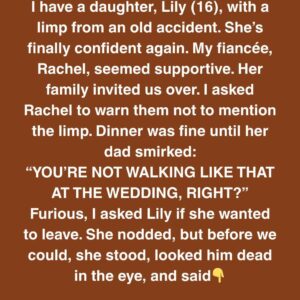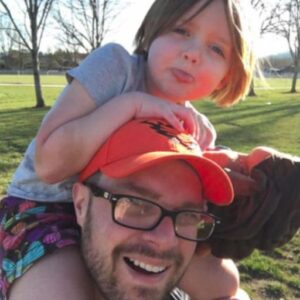
I wasn’t thrilled when my son Adrian chose a boarding school two hours away, but I told myself it’d build his independence. What I didn’t expect was to show up on the first parent visit and see him walking across the lawn barefoot, looking happier than I’d seen in years.
At first, I thought he lost his shoes. But then I noticed everyone—staff, students, even the principal—either had no shoes on or were slipping around in socks. It wasn’t a punishment or a quirky one-off. It was… the norm.
“They call it ‘grounded learning,’” Adrian told me. “We’re allowed to go barefoot almost everywhere. It’s part of how they teach mindfulness and focus.”
I laughed at first. But then he said something that stopped me.
“I don’t fidget anymore in class. I actually listen. And I feel calm all the time now. Like my thoughts don’t have to fight so hard.”
I brushed it off until I saw his grades. Then his art portfolio. Then the email from his teacher about how he helped another student through a panic attack during exams.
Before this, Adrian struggled with anxiety. Always tapping his feet, chewing sleeves, zoning out. We tried therapy, meds, tutors.
But here he was, standing barefoot on a patch of grass, telling me things like—”I figured out I think better when I feel the ground.”
I was skeptical. I mean, I grew up in a strict academic environment. Clean shoes, clean shirts, clean answers. The idea that ditching footwear could untangle my son’s nerves felt… cute, but unlikely.
Still, I couldn’t argue with the results. Adrian wasn’t just more focused—he was more himself. The timid boy who once avoided eye contact now stood tall, hair tousled by the breeze, smiling like he’d discovered a secret.
At lunch, he introduced me to his friends—just as shoeless, just as bright-eyed. They spoke to each other with ease, no phones in sight. One of the girls, Priya, told me, “Walking barefoot reminds us we’re not separate from the world. You don’t zone out when you can feel the earth under you.”
It all sounded like poetic nonsense to me. But Adrian looked so proud standing among them. His eyes sparkled in a way I hadn’t seen since he was little.
On the drive back home, I kept thinking about it. What if the real change wasn’t about the shoes, but what they symbolized?
Letting go.
A week later, Adrian called me to say he was entering an art competition. Not just entering—he was excited about it. The same kid who once refused to even show his doodles at family dinner was now talking about painting “emotions through texture.”
He even described a piece he was working on—something about layered soil tones and bare footprints moving across a canvas.
“Healing is movement,” he said. “And movement doesn’t always need direction.”
I had no idea where he was getting all this wisdom, but I listened. For the first time in years, I just listened.
Then came the twist.
In January, Adrian asked if he could stay on campus during winter break to help with a new student integration program. My initial reaction was hurt. Was he choosing a school over Christmas with family?
But he explained, “There’s a kid named Mateo. He’s having a hard time adjusting. He reminds me of how I used to be. I think I can help.”
How could I say no to that?
So we postponed Christmas until the New Year. And when Adrian finally came home, something unexpected happened.
He kept going barefoot—around the house, in the backyard, even to the corner store. I tried to joke about it, but he just shrugged.
“I don’t need to wear shoes unless I want to. It’s not rebellion. It’s comfort.”
But what shocked me most was how other kids in the neighborhood responded. One of the neighbor’s kids, Jamie, who rarely played with anyone, started hanging out in our backyard with Adrian. Soon they were painting together, sitting on the grass, both barefoot, both quietly creating something beautiful.
One evening, Jamie’s mom knocked on my door. She looked teary-eyed.
“I don’t know what your son’s doing, but… Jamie hasn’t smiled like this in months. He says Adrian told him it’s okay to feel ‘unplugged.’ He’s even talking about going back to school full-time.”
I didn’t know what to say. All I could do was thank her and later tell Adrian how proud I was.
He shrugged again but smiled wide. “People don’t need fixing, Mom. They just need space. And softness under their feet doesn’t hurt.”
I thought about that all night.
In March, the school invited parents to a spring open day. I went, curious to see more. They offered workshops to show how grounded learning worked. I half-expected it to be new-age fluff, but I signed up for one anyway.
They had us take off our shoes and walk a nature trail in silence. No phones, no talking—just listening to the birds, the leaves, the feel of damp earth.
At first, I felt ridiculous. But a few minutes in, something shifted.
I stopped thinking about emails and deadlines and how silly I probably looked. I just… walked. The coolness of the ground, the unevenness, the squish of mud—it made me pay attention. Not in a stressful way. In a present way.
Afterwards, the teacher leading the workshop said, “We’re not teaching kids to ignore the world. We’re teaching them to feel it. To connect before they try to control.”
That line stayed with me.
I drove home that evening barefoot. Kept my shoes on the passenger seat. I didn’t tell anyone. It felt like a secret between me and the road.
By the end of the school year, Adrian’s confidence was unshakable. He was invited to showcase his artwork at a local gallery. His piece—called “Rooted Flight”—was a hit.
It showed a pair of bare feet lifting slowly off the ground, turning into wings. People crowded around it, moved by the quiet symbolism.
A woman beside me whispered, “It feels like how I used to be as a kid. Free.”
And that’s when it clicked.
This school hadn’t changed Adrian into someone else. It had helped him return to who he was before anxiety built its cage.
The final twist came later that summer.
Adrian applied for an internship at a center for kids with behavioral challenges. It was competitive. The kind of thing where they usually picked college students or psychology majors.
But he got it.
When I asked how, he showed me the recommendation letter his teacher wrote. It said:
“Adrian has an intuitive ability to connect with others, not through instruction but presence. He teaches by listening. By standing beside others barefoot in both body and spirit. I cannot think of anyone better to help a child feel seen.”
That letter brought tears to my eyes.
And now, looking back on everything—the school visit, the art, the muddy feet, the backyard afternoons—I realize the barefoot thing was never really about the feet.
It was about trust.
Trusting the ground would hold you. Trusting that if you stop numbing out and start feeling again—even the discomfort—you’ll find your way.
Adrian is still the same boy. He still chews on pencils sometimes. He still gets nervous before big events. But now, he knows how to center himself. How to walk through the world in his own rhythm.
And me?
Well… I’ve stopped wearing shoes in the house. Started painting a little. I even bought a canvas. Called it “First Steps.”
Not because I’m starting over.
But because I finally understand that healing isn’t about speed. It’s about noticing the ground you’re walking on—and choosing to keep walking, no matter how long it takes.
So, if you ever feel lost, anxious, or like the world’s too loud—try taking off your shoes. Literally or metaphorically.
Feel where you are.
And maybe, just maybe, you’ll find out that your next step isn’t as heavy as it seemed.
Because sometimes, the path to peace starts not with a giant leap—but with bare feet on cool grass.
If this story moved you, or made you think of someone who could use a little grounding, please like and share it. You never know whose life you might be quietly touching—one step at a time.





